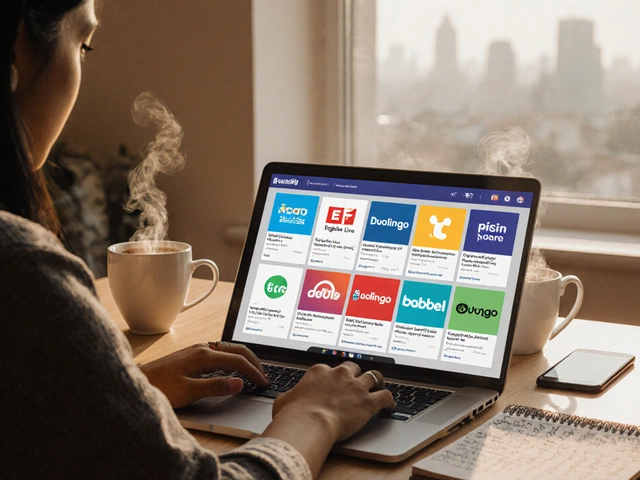
So, you're stuck between eLearning and classroom learning, huh? It's a tough choice, kind of like deciding between your cozy bed and a good workout. Both have their perks, but let’s dig into what really sets them apart.
eLearning is all the rage these days. It's like having your classroom anywhere you want—on your couch, in a coffee shop, or even at the park while your kid runs around. Super flexible, right? You can learn at your own pace, which is awesome if you're juggling other responsibilities. Freedom is the name of the game here. Plus, no more dreading those early morning commutes.
But wait, let’s not dismiss classroom learning just yet. There’s something about being physically present, isn’t there? Engaging in discussions, catching up on the latest gossip—oops, I mean educational insights—with classmates, and being right in front of your teacher can really make things click. It’s a chance to connect, share ideas, and gain perspectives that you might miss online. So, thinking about how each method fits into your lifestyle can really help you choose what's right.
- Understanding eLearning
- Advantages of Classroom Learning
- Challenges in Both Modes
- Tips for Choosing the Right Style
Understanding eLearning
eLearning, or electronic learning, is basically learning that's hopped onto your computer or tablet. It's way more than just watching videos, though that’s definitely part of it. With the rise of technology, the world of education opened up a new dimension where learning isn't confined to a classroom anymore. Instead, it's right there in your living room—on demand.
One cool thing with eLearning is its flexibility. Take it from someone who has tried to study with a cat, Luna, frequently napping on the keyboard. You can adjust the pace to suit your schedule, which is perfect if you're balancing classes with other commitments. Can you imagine pausing a class in a traditional school and picking it up exactly where you left off later? It’s a game-changer for many.
eLearning platforms often include interactive elements like quizzes, assignments, and even discussion boards where you chat with peers from all over. This connectivity means global perspectives come into play, enriching the learning experience. And with the latest platforms, there's real interaction, simulations, and even gamified learning.
Let's be honest. If you've ever zoned out in class—who hasn't, right?—eLearning might offer just the type of engagement to snap you back into focus. Multimedia content such as videos, infographics, and interactive elements can make learning more enjoyable and less of a chore.
| Type of eLearning | Features |
|---|---|
| Self-paced | Learn at your own speed, access courses anytime |
| Synchronous | Real-time classes, often with video conference tools |
The critical part is figuring out if eLearning suits your style. It’s there for the go-getters who love flexibility, and the tech-savvy folks who enjoy learning through apps and online resources.
Advantages of Classroom Learning
Alright, so let's talk about why classroom learning has stuck around despite the tech boom with eLearning. There's a certain vibe you just can't replicate online, right? First up, the structure. Having a routine and a set schedule can really help some folks stay on track. You're there, you've committed your time, so it's easier to focus.
Then there's face-to-face interaction. It's not just about exchanging words; it's the non-verbal cues, the spontaneous discussions that can spark new ideas. Ever notice how a brief chat after class can lead to a whole new perspective or solution you hadn't thought of?
Next, we might underestimate the power of a social environment. Learning alongside others motivates and even spurs a little healthy competition. Plus, having peers around matters—whether for quick help on assignments or forming study groups before a big test.
- Instant Feedback: One of the big pluses is getting immediate feedback from your teachers. If you're stuck on a problem, you can raise your hand and get help right away, instead of waiting for an email response.
- Hands-On Experience: Especially for subjects like science or arts, being in a classroom gives access to equipment and resources that just aren't available online.
- Discipline and Time Management: Regular attendance helps in forming a daily routine, which can make managing your time across studies and other stuffs a bit simpler.
It turns out, a lot of these benefits come from being right there in the thick of it. Sure, you’ve got to deal with the commute and being up early, but for many, that's a small price for a genuine learning experience. Being around classmates offers real-life networking opportunities, and these connections can sometimes be more impactful than any online chat group.

Challenges in Both Modes
Diving into eLearning and classroom learning, it's clear that neither is a magical solution. Both have their quirks, and knowing them might save you from a headache or two down the line. So, let's roll up our sleeves and see what challenges come with each.
Starting with eLearning, ever tried concentrating while your cat is performing gymnastic tricks, like Luna does? Distractions at home can really test your focus. Plus, the self-discipline needed to complete courses can be daunting, especially when binge-watching the latest series is just a click away. Tech issues are another common pitfall. Imagine being in the middle of an exam, and poof, your Wi-Fi decides to take a nap. Frustrating, right?
When it comes to classroom learning, it has its own set of hurdles. First up, flexibility goes out the window. You’re stuck with a fixed schedule, which might clash with work or family time. Ever had to miss Mira's soccer game because of a class? Those are the tough choices you might face. Commuting can also eat up a chunk of your day, not to mention the rush-hour blues.
For both eLearning and classroom learning, motivation can be a big uphill battle. Without the right drive, it’s easy to feel like you’re just going through the motions. And let's not forget about cost. With eLearning, there might be tech costs involved, while traditional learning often comes with travel and material expenses.
- Motivation: Keeping it up is key, whether you're learning online or in a classroom.
- Cost: Consider expenses for tech and travel, depending on the mode.
- Focus: Stay disciplined regardless of potential distractions.
So, while both styles come with their baggage, knowing these challenges can help you make informed decisions and, hopefully, find a path that's a better fit for you and your unique needs.
Tips for Choosing the Right Style
Alright, so you're trying to figure out which learning style suits you best—eLearning or classroom learning. Don’t worry, you're not alone in this dilemma. Let's break down some tips to help you decide.
First off, ask yourself a couple of questions: Do I need flexibility in my schedule? Am I self-motivated? If you answered yes to both, then eLearning might be your best bet. Accessing courses whenever suits you keeps things super flexible.
Consider your learning style. If you thrive on interaction and real-time discussions, a classroom setting could be more beneficial. There's something about face-to-face interaction and immediate feedback that can enhance understanding.
- Your Learning Goals: Are you looking to gain specific skills or dive deep into a subject? eLearning often includes niche courses taught by experts around the world.
- Technical Comfort: Are you comfortable navigating online platforms? eLearning requires a certain level of tech savvy.
- Accessibility: Do you have reliable internet access and technology? That's a must for online learning.
Financial considerations also play a role. While classroom courses often include additional costs like transportation and materials, eLearning usually has fewer expenses, which can be a bonus.
If you’re the type who benefits from structure, the routine of classroom learning might keep you on track better. It has set class times and a dedicated space, which can motivate you to stay disciplined.
Sometimes, blending both can be the sweet spot if the situation allows. Many institutions offer hybrid models, combining the best of both worlds.
Let me throw in a quick stat: According to a study, 77% of academic leaders rated learning outcomes in online education as the same or superior to those in traditional settings. That’s some food for thought!





